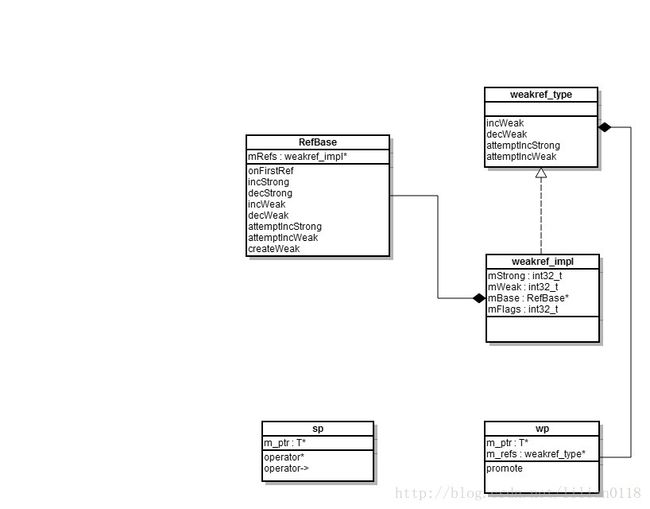Android智能指针分析(sp、wp)
在Android native编写代码时,会经常接触到sp、wp,sp并不是smart pointer的意思,而是strong point;wp就是weak pointer。这两个概念比较像JAVA中的强弱引用,使用sp和wp可以让编程人员不需要再关系内存的释放问题,防止内存泄露。下面先来看它们的类关系图:
要实现内存的自动释放,sp、wp必须结合RefBase这个类来使用,在Android中,大多数类的最上层基类都是RefBase类。我们举个简单的例子,然后顺着这个例子来分析RefBase、sp和wp四种不同的应用,并介绍其实现。
class A : public RefBase
{
}
上面定义一个类A,继承与RefBase,下面我们首先来看RefBases的构造函数:
RefBase::RefBase()
: mRefs(new weakref_impl(this))
{
}
weakref_impl(RefBase* base)
: mStrong(INITIAL_STRONG_VALUE)
, mWeak(0)
, mBase(base)
, mFlags(0)
{
}在RefBase中,首先构造weakref_impl对象,在weakref_impl对mStong和mWeak进行强弱引用计数赋初始值,INITIAL_STRONG_VALUE是0X10000000,这里不直接赋初始值为0,是方便我们区分,0到底是初始化的值,还是在sp释放后再变为0,方便做不同的处理。
列举第一种应用:只有sp指针,没有wp指针的应用
{
sp spA(new A);
}
首先来看sp的构造函数:
template
sp::sp(T* other)
: m_ptr(other) {
if (other)
other->incStrong(this);
} 首先将实际的A对象的指针赋给m_ptr,然后调用A对象的incStrong方法,由上面的类图关系,我们知道这里会调用RefBase的incStrong方法:
void RefBase::incStrong(const void* id) const
{
weakref_impl* const refs = mRefs;
refs->incWeak(id);
refs->addStrongRef(id);
const int32_t c = android_atomic_inc(&refs->mStrong);
ALOG_ASSERT(c > 0, "incStrong() called on %p after last strong ref", refs);
if (c != INITIAL_STRONG_VALUE) {
return;
}
android_atomic_add(-INITIAL_STRONG_VALUE, &refs->mStrong);
refs->mBase->onFirstRef();
}这里首先调用weakref_impl的incWeak方法来增加弱指针引用数;addStrongRef用于debug版本,正式版中没有实现;android_atomic_inc是一个原子操作,增加refs->mStrong的强指针引用数,并返回原值;如果是第一次引用改对象,则还会调用A对象的onFirstRef方法。首先来看incWeak的实现:
void RefBase::weakref_type::incWeak(const void* id)
{
weakref_impl* const impl = static_cast(this);
impl->addWeakRef(id);
const int32_t c = android_atomic_inc(&impl->mWeak);
ALOG_ASSERT(c >= 0, "incWeak called on %p after last weak ref", this);
} 这里还是调用android_atomic_inc去增加weakref_impl的mWeak计数。经过构造函数,mStong和mWeak的计数都变成了1。当spA对象退出作用域以后,就会调用其析构函数来释放这个对象:
template
sp::~sp() {
if (m_ptr)
m_ptr->decStrong(this);
}
void RefBase::decStrong(const void* id) const
{
weakref_impl* const refs = mRefs;
refs->removeStrongRef(id);
const int32_t c = android_atomic_dec(&refs->mStrong);
ALOG_ASSERT(c >= 1, "decStrong() called on %p too many times", refs);
if (c == 1) {
refs->mBase->onLastStrongRef(id);
if ((refs->mFlags&OBJECT_LIFETIME_MASK) == OBJECT_LIFETIME_STRONG) {
delete this;
}
}
refs->decWeak(id);
} sp对象的析构函数调用RefBase的decStrong来减少强弱引用指针计数。weakref_impl的removeStrongRef用于debug版本;调用android_atomic_dec减少mStrong计数并返回原值,如果mStrong之前为1了,这是再减少,说明已经没有其它sp指针引用了,这时候首先调用A对象的onLastStrongRef方法,如果Flag设定的是当前对象的生命周期由sp指针决定(这也是default的设定),则释放掉A对象;然后调用weakref_impl的decWeak去减少弱引用指针计数:
void RefBase::weakref_type::decWeak(const void* id)
{
weakref_impl* const impl = static_cast(this);
impl->removeWeakRef(id);
const int32_t c = android_atomic_dec(&impl->mWeak);
ALOG_ASSERT(c >= 1, "decWeak called on %p too many times", this);
if (c != 1) return;
if ((impl->mFlags&OBJECT_LIFETIME_WEAK) == OBJECT_LIFETIME_STRONG) {
if (impl->mStrong == INITIAL_STRONG_VALUE) {
delete impl->mBase;
} else {
delete impl;
}
} else {
impl->mBase->onLastWeakRef(id);
if ((impl->mFlags&OBJECT_LIFETIME_MASK) == OBJECT_LIFETIME_WEAK) {
delete impl->mBase;
}
}
} 来看判断是否释放的逻辑,如果Flag设定当前对象的生命周期由sp指针决定,并且之前没有初始化过任何sp对象,则直接删除A对象;如果之前由初始化过sp对象,则删除weakref_impl本身,A对象会在RefBase的decStrong中被释放。如果Flag设定当前对象的生命周期由wp指针决定,则首先调用A对象的onLastWeakRef方法,然后删除对象A。在删除对象A的时候,都会调用RefBase的析构函数,我们再来分析RefBase的系统函数:
RefBase::~RefBase()
{
if (mRefs->mStrong == INITIAL_STRONG_VALUE) {
delete mRefs;
} else {
if ((mRefs->mFlags & OBJECT_LIFETIME_MASK) != OBJECT_LIFETIME_STRONG) {
if (mRefs->mWeak == 0) {
delete mRefs;
}
}
}
const_cast(mRefs) = NULL;
} 如果没有初始化过sp对象,则删除mRefs对象;如果Flag设定当前对象的生命周期由wp指针决定并且mWeak计数为0,也删除mRefs对象。
列举第二种应用:只有wp指针,没有sp指针的应用
{
wp wpA(new A);
}
首先来看wp的构造方法:
template
wp::wp(const sp& other)
: m_ptr(other.m_ptr)
{
if (m_ptr) {
m_refs = m_ptr->createWeak(this);
}
} 首先将A对象的指针赋予给m_ptr,可见在sp和wp中都保存有A对象的实际指针,但wp中并没有重载"->",所以wp并不能直接调用A对象的方法,并且由前面sp的知识,我们知道,在decStrong的时候,有可能A对象会被释放,并不会care 是否存在wp的引用。然后调用A对象的createWeak方法,实际上是调用RefBase的这个方法。注意的是在wp中,m_refs是weakref_type的指针;而在RefBase中,mRefs是weakref_impl的指针,所以在下面的代码返回时要注意类型的转型。
RefBase::weakref_type* RefBase::createWeak(const void* id) const
{
mRefs->incWeak(id);
return mRefs;
}
void RefBase::weakref_type::incWeak(const void* id)
{
weakref_impl* const impl = static_cast(this);
impl->addWeakRef(id);
const int32_t c = android_atomic_inc(&impl->mWeak);
ALOG_ASSERT(c >= 0, "incWeak called on %p after last weak ref", this);
} 这里只会增加mWeak 计数,这是mStrong等于INITIAL_STRONG_VALUE,mWeak等于1。当wpA退出作用域后,调用wp的析构函数:
template
wp::~wp()
{
if (m_ptr) m_refs->decWeak(this);
} decWeak函数我们上面讲过,如果Flag设定当前对象的生命周期由sp指针决定,并且之前没有初始化过任何sp对象,则直接删除A对象;并在RefBase的析构函数中取释放mRefs对象。
列举第三种应用:既有sp指针,又有wp指针的应用
{
sp spA(new A)
wp wpA(spA);
}
从上面它们的构造函数我们知道,这是mStong等于1,mWeak等于2。在spA和wpA退出作用域时,首先调用wp的析构函数,再调用sp的析构函数。在wp析构函数中,只会减少mWeak计数为1,然后就然后了。再到sp的析构函数中,就和我们前面介绍的第一种应用一样了。
列举第四种应用:wp指针如果调用对象的方法
前面说过在wp中并没有重载"->",所以wp并不能直接调用A对象的方法,并且由前面sp的知识,我们知道,在decStrong的时候,有可能A对象会被释放,所以在wp中想要调用A对象的方法,必须获得sp指针,这是通过wp的promote方法实现的:
template
sp wp::promote() const
{
sp result;
if (m_ptr && m_refs->attemptIncStrong(&result)) {
result.set_pointer(m_ptr);
}
return result;
}
这里调用weakref_type的attemptIncStrong方法去尝试增加mStrong计数:
bool RefBase::weakref_type::attemptIncStrong(const void* id)
{
incWeak(id);
weakref_impl* const impl = static_cast(this);
int32_t curCount = impl->mStrong;
while (curCount > 0 && curCount != INITIAL_STRONG_VALUE) {
if (android_atomic_cmpxchg(curCount, curCount+1, &impl->mStrong) == 0) {
break;
}
curCount = impl->mStrong;
}
if (curCount <= 0 || curCount == INITIAL_STRONG_VALUE) {
if ((impl->mFlags&OBJECT_LIFETIME_WEAK) == OBJECT_LIFETIME_STRONG) {
if (curCount <= 0) {
decWeak(id);
return false;
}
while (curCount > 0) {
if (android_atomic_cmpxchg(curCount, curCount + 1,
&impl->mStrong) == 0) {
break;
}
curCount = impl->mStrong;
}
if (curCount <= 0) {
decWeak(id);
return false;
}
} else {
if (!impl->mBase->onIncStrongAttempted(FIRST_INC_STRONG, id)) {
decWeak(id);
return false;
}
curCount = android_atomic_inc(&impl->mStrong);
}
if (curCount > 0 && curCount < INITIAL_STRONG_VALUE) {
impl->mBase->onLastStrongRef(id);
}
}
impl->addStrongRef(id);
curCount = impl->mStrong;
while (curCount >= INITIAL_STRONG_VALUE) {
if (android_atomic_cmpxchg(curCount, curCount-INITIAL_STRONG_VALUE,
&impl->mStrong) == 0) {
break;
}
curCount = impl->mStrong;
}
return true;
} 首先调用incWeak来增加mWeak计数,因为这里需要获取sp指针,在sp的构造函数我们知道,会同时增加mWeak和mStrong值。然后根据mStong值分两种情况讨论:
1. 当前面存在sp的引用,即curCount > 0 && curCount != INITIAL_STRONG_VALUE,这时直接让mStrong加1。
2.当前面不存在sp的引用,需要结合Flag去判断。又分为以下几种情况:
一. Flag = OBJECT_LIFETIME_STRONG,并且curCount等于0。说明之前的sp对象已经释放,由前面的知识我们知道,在释放sp对象的同时也会释放对象A,所以这里调用decWeak来释放前面增加的一次mWeak值并返回false
二.Flag = OBJECT_LIFETIME_STRONG,并且curCount = INITIAL_STRONG_VALUE,说明前面没有sp引用,这时我们可以增加mStrong值。
三.Flag = OBJECT_LIFETIME_WEAK,并且curCount <= 0 || curCount == INITIAL_STRONG_VALUE,则调用RefBase的onIncStrongAttempted去尝试增加mStrong值
当上面任何一种情况增加了mStrong值以后,mSrong的值可能大于INITIAL_STRONG_VALUE,我们需要去修正mStrong,就是通过减去INITIAL_STRONG_VALUE计算。当attemptIncStrong返回true时,promote方法就会调用sp的set_pointer方法去设置StrongPointer中的实际A对象的指针。接下来就可以通过sp调用相关的方法了。
